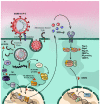Could Antigen Presenting Cells Represent a Protective Element during SARS-CoV-2 Infection in Children?
- PMID: 33920011
- PMCID: PMC8071032
- DOI: 10.3390/pathogens10040476
Could Antigen Presenting Cells Represent a Protective Element during SARS-CoV-2 Infection in Children?
Abstract
Antigen Presenting Cells (APC) are immune cells that recognize, process, and present antigens to lymphocytes. APCs are among the earliest immune responders against an antigen. Thus, in patients with COVID-19, a disease caused by the newly reported SARS-CoV-2 virus, the role of APCs becomes increasingly important. In this paper, we dissect the role of these cells in the fight against SARS-CoV-2. Interestingly, this virus appears to cause a higher mortality among adults than children. This may suggest that the immune system, particularly APCs, of children may be different from that of adults, which may then explain differences in immune responses between these two populations, evident as different pathological outcome. However, the underlying molecular mechanisms that differentiate juvenile from other APCs are not well understood. Whether juvenile APCs are one reason why children are less susceptible to SARS-CoV-2 requires much attention. The goal of this review is to examine the role of APCs, both in adults and children. The molecular mechanisms governing APCs, especially against SARS-CoV-2, may explain the differential immune responsiveness in the two populations.
Keywords: Antigen Presenting Cells (APC); COVID-19; IFN-signaling; SARS-CoV-2; cytokine storm; juvenile immunity.
Conflict of interest statement
The authors declare that the research was conducted in the absence of any commercial or financial relationships that could be construed as a potential conflict of interest.
Figures



Similar articles
-
Contribution of monocytes and macrophages to the local tissue inflammation and cytokine storm in COVID-19: Lessons from SARS and MERS, and potential therapeutic interventions.Life Sci. 2020 Sep 15;257:118102. doi: 10.1016/j.lfs.2020.118102. Epub 2020 Jul 18. Life Sci. 2020. PMID: 32687918 Free PMC article. Review.
-
The role of antigen-presenting cells in the pathogenesis of COVID-19.Pathol Res Pract. 2022 May;233:153848. doi: 10.1016/j.prp.2022.153848. Epub 2022 Mar 23. Pathol Res Pract. 2022. PMID: 35338971 Free PMC article. Review.
-
Silence of the Lambs: The Immunological and Molecular Mechanisms of COVID-19 in Children in Comparison with Adults.Microorganisms. 2021 Feb 7;9(2):330. doi: 10.3390/microorganisms9020330. Microorganisms. 2021. PMID: 33562210 Free PMC article. Review.
-
Murine Coronavirus Disease 2019 Lethality Is Characterized by Lymphoid Depletion Associated with Suppressed Antigen-Presenting Cell Functionality.Am J Pathol. 2023 Jul;193(7):866-882. doi: 10.1016/j.ajpath.2023.03.008. Epub 2023 Apr 5. Am J Pathol. 2023. PMID: 37024046 Free PMC article.
-
SARS-CoV-2 will constantly sweep its tracks: a vaccine containing CpG motifs in 'lasso' for the multi-faced virus.Inflamm Res. 2020 Sep;69(9):801-812. doi: 10.1007/s00011-020-01377-3. Epub 2020 Jul 12. Inflamm Res. 2020. PMID: 32656668 Free PMC article.
Cited by
-
Implications of the Immune Polymorphisms of the Host and the Genetic Variability of SARS-CoV-2 in the Development of COVID-19.Viruses. 2022 Jan 6;14(1):94. doi: 10.3390/v14010094. Viruses. 2022. PMID: 35062298 Free PMC article. Review.
-
A bird's eye view on the role of dendritic cells in SARS-CoV-2 infection: Perspectives for immune-based vaccines.Allergy. 2022 Jan;77(1):100-110. doi: 10.1111/all.15004. Epub 2021 Jul 24. Allergy. 2022. PMID: 34245591 Free PMC article. Review.
-
SARS-CoV-2 Variants, Vaccines, and Host Immunity.Front Immunol. 2022 Jan 3;12:809244. doi: 10.3389/fimmu.2021.809244. eCollection 2021. Front Immunol. 2022. PMID: 35046961 Free PMC article. Review.
-
COVID-19 Immunobiology: Lessons Learned, New Questions Arise.Front Immunol. 2021 Aug 26;12:719023. doi: 10.3389/fimmu.2021.719023. eCollection 2021. Front Immunol. 2021. PMID: 34512643 Free PMC article. Review.
-
Mechanisms of Cardiovascular System Injury Induced by COVID-19 in Elderly Patients With Cardiovascular History.Front Cardiovasc Med. 2022 May 4;9:859505. doi: 10.3389/fcvm.2022.859505. eCollection 2022. Front Cardiovasc Med. 2022. PMID: 35600485 Free PMC article. Review.
References
-
- Wormser G.P., Prasad A., Neuhaus E., Joshi S., Nowakowski J., Nelson J., Mittleman A., Aguero-Rosenfeld M., Topal J., Krause J.P. Emergence of resistance to azithromycin-atovaquone in immunocompromised patients with Babesia microti infection. Clin. Infect. Dis. 2010;50:381–386. doi: 10.1086/649859. - DOI - PubMed
Publication types
LinkOut - more resources
Full Text Sources
Other Literature Sources
Miscellaneous

